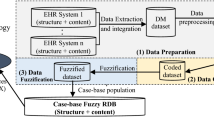Abstract
The case-based reasoning (CBR) architecture described in this paper represents a substantive advancement in the representation of case-knowledge. It addresses three major problems found in current CBR schemes: 1) Insufficient treatment of abstract case features' context-dependent characteristics. 2) Lack of a methodical support for atomic and structured case features that contain and represent imprecisely specified quantities. 3) And little account for clustering and organising cognate cases into conceptually overlapping categories. To overcome the representational inadequacy resulting from those deficiencies, this work proposes two modelling fundamentals, namely, fuzzy primitive and fuzzy complex abstract features. These allow a flexible, polymorphic encoding of case characteristics as real numbers, linguistic terms, fuzzy numbers and fuzzy complex objects respectively. Based on this concept, it is possible to systematically organise a case base in fuzzy categories, reflecting real-world case clusters. In the presented scheme, a prototype case and its associated approximation scales form the basis to realise a versatile mechanism to represent the context-specific idiosyncrasies of fuzzy abstract case features. Case categories, fuzzy abstract features, cases, and the approximation scale concept are modelled as self-contained, operational entities. They co-operatively concert their services when they categorise an unclassified problem description (target case), and locate relevant stored cases. Applied to the Coronary Heart Disease risk assessment domain, the proposed architecture has proven to be highly adequate for capturing and efficiently processing case-knowledge. Moreover, as this scheme is designed upon well-established object-oriented principles, it has been shown that it can seamlessly integrate in a wider, more general knowledge management regime.
Similar content being viewed by others
References
A. Aamodt, “A knowledge-intensive approach to problem solving and sustained learning,” Ph.D. dissertation, University of Trondheim, Norwegian Institute of Technology, 1991.
A. Aamodt and E. Plaza, “Case-based reasoning: Foundational issues, methodological variations, and system approaches,” AICOM, vol. 7,no. 1, March 1994.
J.S. Aikins, “Prototypical knowledge for expert systems. A retrospective analysis,” in Artificial Intelligence, vol. 59, pp. 207, 1993.
R. Bareiss, Exemplar-Based Knowledge Acquisition: A Unified Approach to Concept Representation, Classification, and Learning, Academic Press: Boston, 1989.
R. Brandau, A. Lemmon, and C. Lafond, “Experience with extended episodes: Cases with complex temporal structure,” in Proc. Case-Based Reasoning Workshop, Morgan Kaufmann Publishers, Inc., 1991.
M.G. Brown, “An underlying memory model to support case retrieval,” in Proc. First European Workshop on Case-Based Reasoning, Kaiserslautern, Germany, 1993, p. 20.
B.P. Buckles and F.E. Petry, “A fuzzy representation of data for relational databases,” in Fuzzy Sets and Systems, vol. 7, p. 213, 1982.
R.G.G. Cattel (Ed.), The Object Database Standard: ODMG (1.1), Morgan Kaufmann Publishers: California, 1994.
S.-J. Chen and C.-L. Hwang, Fuzzy Multiple Attribute Decision Making, Methods and Applications, Springer Verlag, 1992.
Y. Cheng, “Context-dependent similarity,” in Uncertainty in Artificial Intelligence 6, North-Holland, p. 42, 1991.
Common Object Request Broker: Architecture and Specification, The Object Management Group and X/Open, 1991.
W. Dubitzky, F. Carville, and J.G. Hughes, “Case-level knowledge modelling,” in Proc. Irish Conference on Artificial Intelligence and Cognitive Science, 1993.
W. Dubitzky, A. Schuster, J.G. Hughes, and D.A. Bell, “Conceptual distance of numerically specified case features,” in Proc. The Second New Zealand International Two-Stream Conference on Artificial Neural Networks and Expert Systems, Dunedin, New Zealand, 1995, p. 210.
W. Dubitzky, J.G. Hughes, and D. Bell, “Knowledge Management via the synergy of case-knowledge and object-oriented information management,” to appear in the Proc. Third World Congress on Expert Systems, Korea, Feb. 1996.
D. Dubois and H. Prade, “Fuzzy sets in approximate reasoning, Part 1: Inference with possibility distributions,” in Fuzzy Sets and Systems, North Holland, vol. 40, p. 143, 1991.
A. Foß (Ed.), “FABEL: Similarity concepts and retrieval methods,” FABEL Report Number 13, Gesellschaft für Mathematik und Datenverarbeitung mbH, Sankt Augustin, Germany, 1994.
R. George, B.P. Buckles, and F.E. Petry, “Modelling class hierarchies in the fuzzy object-oriented data model,” in Fuzzy Sets and Systems, vol. 60, p. 259, 1993.
A. Goel, J. Kolodner, M. Pearce, R. Billington, and C. Zimring, “Towards a case-based tool for aiding conceptual design problem solving,” in Proc. Case-Based Reasoning Workshop, Washington D.C., 1991, p. 109.
I. Grahamand and P.L. Jones, Expert Systems: Knowledge, Uncertainty Decision, Chapman and Hall, Ltd.: New York, 1988.
J.G. Hughes, Object-Oriented Databases, Prentice Hall International (UK) Ltd., 1991.
G.J. Klir and T.A. Folger, Fuzzy Sets, Uncertainty and Information, Prentice Hall: Englewood Cliffs, NJ, 1988.
J. Kolodner, Case-Based Reasoning, Morgan Kaufmann Publishers, Inc.: San Mateo, CA, 1993.
P. Lopes, R.H. Mitchell, and J.A. White, “The relationships between respiratory sinus arrhythmia and coronary heart disease risk factors in middle-aged males,” in Automedica, vol. 16, p. 71, 1994.
G.A. Miller, “The magic number seven, plus or minus seven,” in Psychological Review, vol. 63, p. 81, 1965.
B. Porter, R. Bareissan, and R Holte, “Concept learning and heuristic classification in weak theory domains,” in Artificial Intelligence, vol. 45,nos. 1/2, p. 229, 1990.
E.H. Ruspini, “Possibility as similarity: The semantics of fuzzy logic,” in Uncertainty in Artificial Intelligence 6, North-Holland, p. 271, 1991.
A. Stepanov and L. Meng, “The standard template library,” Hewlett-Packard Laboratories, Palo Alto, CA 94304, 1994.
Study Group, European Atherosclerosis Society, “Strategies for the prevention of coronary heart disease: A policy statement of the european atherosclerosis society,” in European Heart Journal, vol. 8, p. 77, 1987.
L.A. Zadeh, “Outline of a new approach to the analysis of complex systems and decision processes,” IEEE Transactions on Systems, Man, and Cybernetics, vol. SMC-3,no. 1, p. 28, Jan. 1973.
Author information
Authors and Affiliations
Rights and permissions
About this article
Cite this article
Dubitzky, W., Schuster, A., Hughes, J. et al. An Advanced Case-Knowledge Architecture Based on Fuzzy Objects. Applied Intelligence 7, 187–204 (1997). https://doi.org/10.1023/A:1008216431052
Issue Date:
DOI: https://doi.org/10.1023/A:1008216431052




